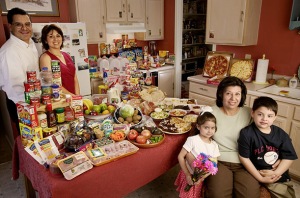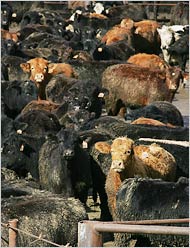A truly amazing concept, a panoramic view of cultural diversity from a diet standpoint. Hungry Planet: What the World Eats dives into the dietary habits of a spectrum of families from different countries featuring pictures of each family behind 1 weeks worth of food. The artists behind this novel concept, photographer Peter Menzel and writer Faith D’Aluisio, visited some 30 families in 24 countries.
This post does not contain all of the families featured in the book but does show large portion. Some things worth noting include the horrific packaging of foods in developed nations. One quickly sees why the industrialized nations produce so much trash. Other visible facts includes the lack of fresh fruits, vegetables, and other produce in the US families. The reality being the cost and convenience of being able to store prepackaged foods for a long period of time while having foods that are quick to prepare.
I hope everyone examines these pictures and takes something from it.

Japan: The Ukita family of Kodaira City
Food expenditure for one week: 37,699 Yen or $317.25
Favorite foods: sashimi, fruit, cake, potato chips

Great Britain: The Bainton family of Cllingbourne Ducis
Food expenditure for one week: 155.54 British Pounds or $253.15
Favorite foods: avocado, mayonnaise sandwich, prawn cocktail, chocolate fudge cake with cream

Italy: The Manzo family of Sicily
Food expenditure for one week: 214.36 Euros or $260.11
Favorite foods: fish, pasta with ragu, hot dogs, frozen fish sticks

United States: The Caven family of California
Food expenditure for one week: $159.18
Favorite foods: beef stew, berry yogurt sundae, clam chowder, ice cream

Chad: The Aboubakar family of Breidjing Camp
Food expenditure for one week: 685 CFA Francs or $1.23
Favorite foods: soup with fresh sheep meat

Kuwait: The Al Haggan family of Kuwait City
Food expenditure for one week: 63.63 dinar or $221.45 Family recipe: Chicken biryani with basmati rice

United States: The Revis family of North Carolina
Food expenditure for one week: $341.98
Favorite foods: spaghetti, potatoes, sesame chicken

Mexico: The Casales family of Cuernavaca
Food expenditure for one week: 1,862.78 Mexican Pesos or $189.09
Favorite foods: pizza, crab, pasta, chicken

China: The Dong family of Beijing
Food expenditure for one week: 1,233.76 Yuan or $155.06
Favorite foods: fried shredded pork with sweet and sour sauce

Egypt: The Ahmed family of Cairo
Food expenditure for one week: 387.85 Egyptian Pounds or $68.53
Family recipe: Okra and mutton

Ecuador: The Ayme family of Tingo
Food expenditure for one week: $31.55
Family recipe: Potato soup with cabbage

Mongolia: The Batsuuri family of Ulaanbaatar
Food expenditure for one week: 41,985.85 togrogs or $40.02
Family recipe: Mutton dumplings

Bhutan: The Namgay family of Shingkhey Village
Food expenditure for one week: 224.93 ngultrum or $5.03
Family recipe: Mushroom, cheese and pork

Germany: The Melander family of Bargteheide
Food expenditure for one week: 375.39 Euros or $500.07
Favorite foods: fried potatoes with onions, bacon and herring, fried noodles with eggs and cheese, pizza, vanilla pudding

Guatemala: The Mendozas of Todos Santos
Food expenditure for one week: 573 Quetzales or $75.70
Family Recipe: Turkey Stew and Susana Perez Matias’s Sheep Soup

India: The Patkars of Ujjain
Food expenditure for one week: 1,636.25 rupees or $39.27
Family Recipe: Sangeeta Patkar’s Poha (Rice Flakes)

United States: The Fernandezes of Texas
Food expenditure for one week: $242.48
Favorite Foods: Shrimp with Alfredo sauce, chicken mole, barbecue ribs, pizza



















